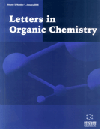- Home
- A-Z Publications
- Letters in Organic Chemistry
- Previous Issues
- Volume 20, Issue 11, 2023
Letters in Organic Chemistry - Volume 20, Issue 11, 2023
Volume 20, Issue 11, 2023
-
-
Heterogeneous Copper-catalyst Anchored on Chitosan Schiff Basemodified Carbon Nanotubes for Click Reaction
More LessAuthors: Soo-Jung Kwak, Seung-Hoi Kim and Ueon Sang ShinA newly designed heterogeneous copper catalytic platform immobilizing copper (II) salt on chitosan Schiff base-modified carbon nanotubes was developed (Cu@CS-Py@CNT). The structure of the catalyst platform was fully characterized by spectroscopic analyses. The catalytic activity of the Cu@CS-Py@CNT was investigated in a one-pot synthesis of 1,4-disubstituted 1,2,3-triazoles by the regioselective click reaction using vari Read More
-
-
-
A Cost-effective and Green Synthesis of Isothiocyanates
More LessAuthors: Qinsheng Li, Junhao Xiong, Jiahao Liao, Qinghua Huang, Zhongyu Hu, Yuping Yang, Zhenhua Xiong and Chuanjie ChengIrritant, expensive, or toxic desulfurating agents are usually used in the synthesis of isothiocyanates from amines, CS2, and appropriate bases, accompanied by a tedious workup. A more practical and green method has been developed. Cheap and non-toxic CaO was used as both a base and a desulfurating agent in the synthesis of isothiocyanates. Both alkyl and aryl isothiocyanates are easily synthesized in moderate to hi Read More
-
-
-
Total Synthesis of Xestodecalactone C via Sharpless Epoxidation and Friedal-Crafts Acylation
More LessAuthors: Chithaluri Sudhakar, Kottolla S. Prasad and Batharaju RameshMarine-derived macrolides that occur naturally exhibit a range of biological properties, including antibacterial and antifungal activity. Sharpless epoxidation and intramolecular acylation via the Friedel-Crafts method for the macrolide ring formation was used as the main steps in the regioselective construction of naturally existing xestodecalactone C, which was started from chiral propylene oxide. The isolated yellow Read More
-
-
-
Synthesis and Biological Properties of D-Amino Acids
More LessAuthors: Shikha Sharma, Biswa M. Sahoo and Bimal Krishna BanikIn the past few years, scientists have learned more about how the human body uses Damino acids and how their synthesis occurs. This has rekindled interest in researching them. D-amino acids are known to be important in an extensive variety of physiologic operations taking place inside the human body. The correlation between these radicals and the physiology of human beings is that Daspartate and D-serine affe Read More
-
-
-
Insights Into the Synthetic Strategies, Biological Activity, and Structure- Activity Relationship of Pyridine and Analogs: A Review
More LessAuthors: Aprajita Matthew, Rajnish Kumar, Avijit Mazumder, Salahuddin and Harshita BhadauriaBased on various research reports, pyridine possesses a wide range of pharmacological activities along with many other industrial applications. Because of its diverse applications, pyridine moiety is the center of attraction for researchers, and many patents have been granted focusing on it. Several synthetic protocols, such as cyclo-condensation, cyclization, cycloaddition, electrolysis, etc., were used by researchers to synthe Read More
-
-
-
A Scope of Chiral Cyclopropanations of Various α-functionalized Diazoketone Derivatives with Styrene Catalyzed by p-Nitro Ru(II)-diphenyl- Pheox Complex
More LessAuthors: Le Thi L. Chi and Seiji IwasaFollowing the success of the first intermolecular cyclopropanations of diazo acetoxy acetone with olefins using a novel p-nitro-Ru(II)-diphenyl-Pheox catalyst, other α-functionalized diazoketones have synthesized using the same reaction conditions. Consequently, chiral cyclopropyl products were formed with excellent yield (up to 87% yield), high diastereoselectivity (up to 99:1), and high enantioselectivity (up to 90% ee).
-
-
-
Synthesis of Ferrocenylimidazo[1,2-a]pyridine-3-amines Using Catalyst ZrO(NO3)2.2H2O and their Theoretical Studies
More LessAuthors: Nahid Shajari, Hooriye Yahyaei and Seyyede S. ZafaraniIn this study, synthesis of ferrocenylimidazo[1,2-a]pyridine-3-amines was reported from the condensation reaction of ferrocenecarboxaldehyde, 2-aminopyridine, and isocyanides using ZrO(NO3)2.2H2O as an efficient, new, and reusable catalyst under reflux conditions in ethanol. The structures of the products were confirmed by IR, 1H NMR, 13C NMR, and elemental analysis. Quantum theoretical calculations for the structure of Read More
-
-
-
Novel Approach for the Synthesis of 2, 5-disubstituted 1, 3, 4-thiadiazoles from Benzothiohydrazides and Ethylbenzimidate
More LessIn the current study, a simple and reliable technique for the synthesis of 2,5-disubstituted 1,3,4-thiadiazoles from ethylbenzimidate and benzothiohydrazides were devised. This protocol goes via a base-mediated nucleophilic addition elimination process, followed by intramolecular rearrangement. Our method utilizes commonly accessible and non-toxic substrates and a simple workup procedure to produce high to e Read More
-
-
-
Continuous-flow Synthesis of Ruthenium Nanoparticles using a Microreactor for the Selective Hydrogenation Reaction
More LessIn this study, a continuous flow reactor was used to synthesize Ru nanoparticles with a well-distributed size and good stability. The effects of reactant dilution and flow rate on the synthesis were investigated, and it was found that optimization of these parameters was critical in obtaining small-sized Ru nanoparticles using a solution of 0.00025 M RuCl3.3H2O and 0.001M NaBH4 at a flow rate of 30mL/h. The Ru nanoparticle Read More
-
-
-
A Facile and Green Nitration of Easily-Hydrolyzed Aromatic Compounds Based on Direct Filtration and H2SO4 Recycling
More LessAuthors: Runlai Li, Zhenming Zhang, Jiangyu Ji, He Li, Chi Liu and Shu-an LiThe conventional mixed acid nitration of aromatic hydrocarbons has been extensively applied in the industry, but usually, it is not highly selective and may cause environmental concerns regarding the disposal of large volumes of mixed acids. This paper proposes a new method of orientational para-nitration of easily hydrolyzable aromatic compounds. Under the optimized reaction conditions, the easily hydrolyzed aromatic com Read More
-
Volumes & issues
-
Volume 22 (2025)
-
Volume 21 (2024)
-
Volume 20 (2023)
-
Volume 19 (2022)
-
Volume 18 (2021)
-
Volume 17 (2020)
-
Volume 16 (2019)
-
Volume 15 (2018)
-
Volume 14 (2017)
-
Volume 13 (2016)
-
Volume 12 (2015)
-
Volume 11 (2014)
-
Volume 10 (2013)
-
Volume 9 (2012)
-
Volume 8 (2011)
-
Volume 7 (2010)
-
Volume 6 (2009)
-
Volume 5 (2008)
-
Volume 4 (2007)
-
Volume 3 (2006)
-
Volume 2 (2005)
-
Volume 1 (2004)
Most Read This Month
Article
content/journals/loc
Journal
10
5
false
en


